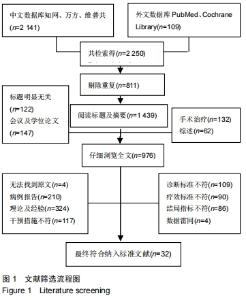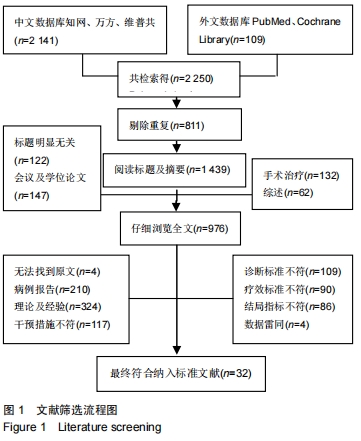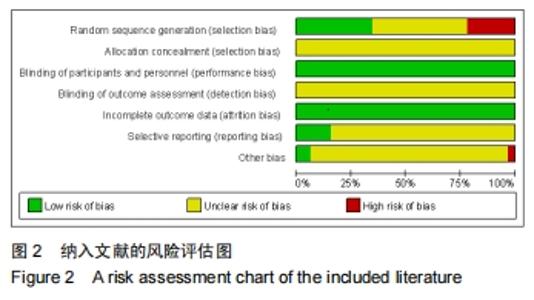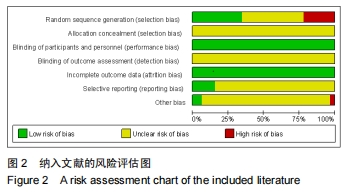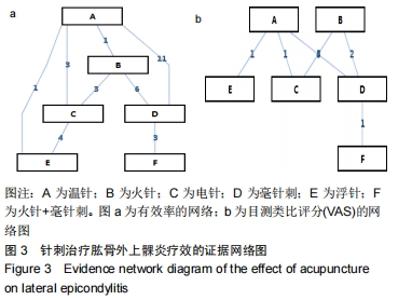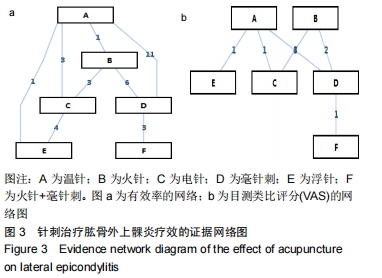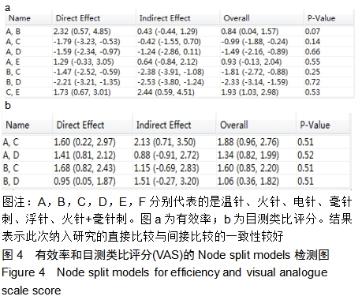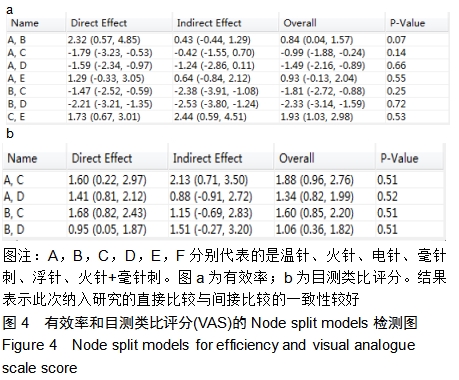Chinese Journal of Tissue Engineering Research ›› 2020, Vol. 24 ›› Issue (23): 3756-3763.doi: 10.3969/j.issn.2095-4344.2729
Previous Articles Next Articles
Various acupuncture therapies for lateral epicondylitis: a Bayesian network meta-analysis
Shi Yuling1, Li Guangyao2, Liang Zujian3
- 1Third Clinical School, 2Acupuncture Rehabilitation School, Guangzhou University of Chinese Medicine, Guangzhou 510405, Guangdong Province, China; 3Orthopedics Hospital, Guangzhou University of Chinese Medicine, Guangzhou 510240, Guangdong Province, China
-
Received:2019-12-02Revised:2019-12-04Accepted:2020-01-10Online:2020-08-18Published:2020-07-30 -
Contact:Liang Zujian, MD, Chief physician, Orthopedics Hospital, Guangzhou University of Chinese Medicine, Guangzhou 510240, Guangdong Province, China -
About author:Shi Yuling, Master candidate, Third Clinical School, Guangzhou University of Chinese Medicine, Guangzhou 510405, Guangdong Province, China -
Supported by:the National Natural Science Foundation of China (General Project), No. 81473756; the Natural Science Foundation of Guangdong Province, No. 2018A0303130103
CLC Number:
Cite this article
Shi Yuling, Li Guangyao, Liang Zujian. Various acupuncture therapies for lateral epicondylitis: a Bayesian network meta-analysis[J]. Chinese Journal of Tissue Engineering Research, 2020, 24(23): 3756-3763.
share this article
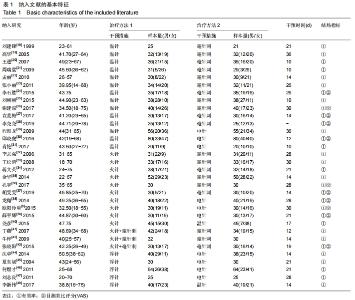
2.2 所纳文献质量评价结果 纳入的32篇文献中有2篇质量较高,其余文献质量一般,其评估的依据主要体现在:①10篇文献在文中详细提及研究时所开展的随机法,但有15篇仅提及了随机字样,7篇按就诊顺序随机;②由于针刺器具及治疗方式的特殊性,故在施术时无法施盲于医患,但由于两方事先了解治疗过程,按循证医学施盲法则的判断,当医患双方在知情的情况下,未做设盲处理时可认为其对治疗结果影响较小[49],但所纳文献均未明确提及结局统计方面是否施盲,这将在一定程度上对结果的公认性有部分影响;③所纳文章均未明确提及分配隐藏与否;④有1篇文章存在人员脱落[37],且文中说明来源于何组别及具体缘由;⑤有3篇文献在随访及复发方面有记录[34,43,48],随访的时间分别为4周、1个月、3个月,且时实记录了详情;⑥有1篇文献提及在所涉的干预措施中治愈网球肘需要的具体疗程[19];⑦1篇文章只提及了治疗频次,无具体疗程[28]。结果详见表1,图2。 "
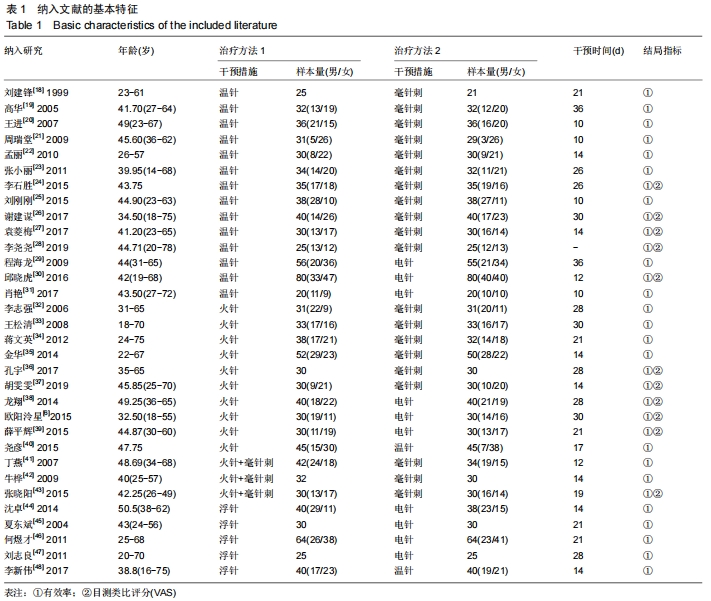
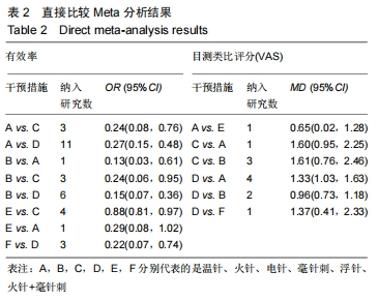
2.3 结果分析 2.3.1 直接比较Meta分析结果 (1)对所纳以有效率为主要指标里两两比较的文献进行Meta分析:结果示浮针优于电针[OR=0.88,95%CI (0.81,0.97)],温针优于毫针刺[OR=0.27,95%CI(0.15,0.48)],温针优于电针[OR =0.24,95%CI(0.08,0.76)],火针+毫针刺优于毫针刺[OR =0.22,95%CI(0.07,0.74)],火针优于毫针刺[OR=0.15,95%CI(0.07,0.36)],火针优于温针[OR= 0.13,95%CI(0.03,0.61)],火针优于电针[OR=0.24,95%CI (0.06,0.95)],剩余浮针与温针的两两比较结果无统计学差异。 (2)对所纳目测类比评分(VAS)为次要结局指标的文献进行分析:结果示浮针优于温针[MD=0.65,95%CI(0.02,1.28)],温针优于毫针刺[MD=1.33,95%CI(1.03,1.63)],温针优于电针[MD=1.60,95%CI(0.95,2.25)],火针+毫针刺优于毫针刺[MD=1.37,95%CI(0.41,2.33)],火针优于毫针刺[MD=0.96,95%CI(0.73,1.18)],火针亦优于电针[MD=1.61,95%CI(0.76,2.46)],纳入文献中目测类比评分作为次要指标的统计学均显示出差异。见表2。 "
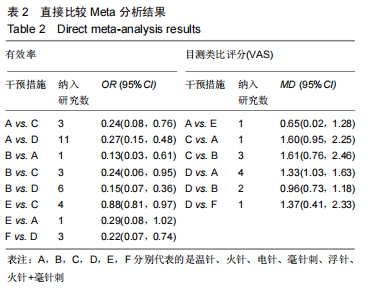

2.3.4 一致性模型下的网状Meta分析及疗效排序 此次所纳32篇文章,共涉及2 318例患者,将此32篇文献的数据基于贝叶斯理论进行数据的拟合并分析[6,18-48],其马尔科夫链-蒙特卡罗(MarkovChain Monte Carlo,MCMC)的参数采用软件预设,其有效率结果见表3所示,结果释为温针优于电针[OR=2.68,95%CI(1.28,6.54)],温针优于毫针刺[OR=4.43,95%CI(2.44,8.71)],火针优于温针[OR=2.32,95%CI(1.04,4.79)],火针优于电针[OR=6.14,95%CI(2.41,15.18)],火针优于毫针刺[OR=10.23,95%CI(4.90,23.05)],浮针优于电针[OR=6.86,95%CI(2.80,19.72)],浮针优于毫针刺[OR=11.86,95%CI(3.58,37.71)],火针+毫针刺优于毫针刺[OR=6.65,95%CI(1.93,30.78)],其余比较均无统计学差异。依据一致性模型下的统计结果,查看疗效排序的概率,具体见图5a,通过直观评估来判断疗效排序,其结果从优到劣依次为:浮针>火针>火针+毫针刺>温针>电针>毫针刺。所纳32篇文章中有12篇文章以目测类比评分作为次要指标,结果见表4,对其进行统计,结果为温针优于电针[MD=-1.88,95%CI(-2.76,-0.96)],温针优于毫针刺[MD=-1.34,95%CI(-1.99,-0.82)],火针优于电针[MD=-1.60,95%CI (-2.20,-0.85)],火针优于毫针刺[MD=-1.06,95%CI (-1.82,-0.36)],浮针优于电针[MD=-2.54,95%CI(-4.08,-0.90)]浮针优于毫针刺 [MD=-2.00,95%CI(-3.46,-0.62)],火针+毫针刺优于电针[MD=-1.90,95%CI(-3.56,-0.09)],其余比较均无明显统计学差异。查看疗效排序的概率,具体见图5b,通过直观评估来判断疗效排序,其结果从优到劣依次为:浮针>火针+毫针刺>火针>温针>毫针刺>电针。 "


2.3.5 非一致性模型检验 当在一致性模型下行结果的统计和分析时,需另行非一致性模型运算以鉴别所得结果稳定与否。首先对有效率的非一致性模型下产生的3个非一致性模型因子进行核对,分别为0.88(-0.39,3.12)、0.11(-1.40,2.02)、0.46(-0.64,2.38),再核对非一致性模型标准差,其为1.07(0.05,2.78)。根据结果其非一致性模型因子95%置信度区间包含0,非一致性模型标准差95%置信度区间包含1,表示一致性模型下的有效率结果稳定且可靠。 其次核对目测类比评分的非一致性模型因子,其为-0.16(-1.52,0.09),再核对非一致性模型标准差,其为0.88(0.04,2.20)。根据结果其非一致性模型因子95%置信度区间包含0,非一致性模型标准差95%置信度区间包含1,表示一致性模型下的目测类比评分结果稳定且可靠。 2.4 发表偏倚分析 用STATA呈现此次网状Meta的漏斗图,以便探析在本研究中的发表偏倚的情况。由图6a示有效率的漏斗图,该图大致对称,但有1项研究在倒置的三角形外,说明存在小样本效应及发表偏倚,据敏感性分析可知该偏倚来源于龙翔等[38]的文章,文章作者认为电针与火针之间无明显差异。图6b示目测类比评分的漏斗图,该图有2点存在三角形外,发现其点为温针vs毫针刺及火针vs电针的文献[26,38],说明存在发表偏倚,仔细分析数据后发现该偏倚不属临床方法及统计学问题造成,且这些文章皆符合文献纳入标准,不应剔除,故应继续纳入并行统计分析。 "

| [1]DA LUZ DC, DE BORBA Y, RAVANELLO EM, et al. Iontophoresis in lateral epicondylitis: a randomized, double-blind clinical trial.J Shoulder Elbow Surg.2019;28(9):1743-1749. [2]ROJAS-MARTÍNEZ M, ALONSO JF, JORDANIĆ M, et al. Analysis of muscle load-sharing in patients with lateral epicondylitis during endurance isokinetic contractions using nonlinear prediction. Front Physiol.2019;10:1185. [3]ALLANDER E. Prevalence, incidence, and remission rates of some common rheumatic diseases or syndromes. Scandinavian journal of rheumatology.1974;3(3):145-153. [4]张笑,罗晓舟,魏燕莹,等.浮针治疗网球肘有效性的系统评价及Meta分析[J].中华中医药学刊,2018,36(9):2172-2176. [5]王元利.电针治疗顽固性肱骨外上髁炎临床疗效观察[J].亚太传统医药, 2018,14(8):165-166. [6]欧阳泠星,郭宪敏,方鑫楷,等.毫火针治疗网球肘疗效观察[J].上海针灸杂志,2015,34(2):161-163. [7]TRINH K, PHILLIPS SD, HO E, et al. Acupuncture for the alleviation of lateral epicondyle pain: a systematic review. Rheumatology.2004; 43(9):1085-1090. [8]BISSET L, PAUNGMALI A, VICENZINO B, et al. A systematic review and meta-analysis of clinical trials on physical interventions for lateral epicondylalgia.Br J Sports Med. 2005;39(7):411-422. [9]GADAU M, YEUNG WF, LIU H, et al. Acupuncture and moxibustion for lateral elbow pain: a systematic review of randomized controlled trials. BMC Complement Altern Med. 2014;14(1):136. [10]董圣杰,冷卫东,田家祥,等.Meta分析系列之五:贝叶斯Meta分析与WinBUGS软件[J].中国循证心血管医学杂志,2012,4(5):395-398. [11]国家中医药管理局编.中医病证诊断疗效标准[M]:南京:南京大学出版社, 1994:189-190. [12]国家中医药管理局.中医病证诊断疗效标准[M].北京:中国医药科技出版社,2012:190-191. [13]吴在德,吴肇汉.外科学[M].7版.北京:人民卫生出版社,2008:833. [14]刘云鹏,刘沂等编著.骨与关节损伤和疾病的诊断分类及功能评定标准[M].北京:VIP出版社,2002:204-205. [15]GERTVAN VALKENHOEF,TOMMI TERVONEN,TIJS ZWINKELS,et al. ADDIS: A decision support system for evidence-based medicine. Decision Support Systems.2013;55(2):459-475. [16]WARN DE, THOMPSON S, SPIEGELHALTER DJ. Bayesian random effects meta‐analysis of trials with binary outcomes: methods for the absolute risk difference and relative risk scales. Stat Med. 2002;21(11): 1601-1623. [17]SMITH TC, SPIEGELHALTER DJ, THOMAS A. Bayesian approaches to random‐effects meta‐analysis: a comparative study. Stat Med. 1995;14(24):2685-2699. [18]刘建锋.磁极针并悬灸治疗网球肘46例临床观察[J].中国针灸,1999, 19(S1): 37. [19]高华.围刺温针法治疗肱骨外上髁炎疗效观察[J].中医药临床杂志,2005, 17(3):280-281. [20]王进.温针治疗肱骨外上髁炎72例临床分析[J].中医药临床杂志,2007, 19(6):604. [21]周瑞堂.温针灸压痛点治疗肱骨外上髁炎31例[J].陕西中医,2009,30(10): 1383-1384. [22]孟丽,王海丰.恢刺加灸法治疗肱骨外上髁炎30例疗效观察[J].国医论坛, 2010,25(3):30. [23]张小丽,蒋海鹰.围刺针法结合隔姜灸治疗肱骨外上髁炎疗效观察[J].内蒙古中医药, 2011, 30(4): 37. [24]李石胜,吴耀持,张峻峰,等.温针齐刺治疗肱骨外上髁炎35例[J].河南中医, 2015,35(6):1334-1335. [25]刘刚刚,孙钰.齐刺加温针灸治疗肱骨外上髁炎疗效观察[J].淮海医药, 2015,33(3):269-270. [26]谢建谋,虞露长.等分角度多向斜透刺配合艾灸治疗肱骨外上髁炎的临床观察[J].中医外治杂志,2017,26(4):42-43. [27]袁菱梅,李艳明.经筋齐刺温针治疗肱骨外上髁炎30例临床观察[J].江苏中医药,2017,49(1):57-58. [28]李尧尧.齐刺加温针灸治疗肱骨外上髁炎的临床效果[J].临床医学研究与实践,2019,4(17):128-129. [29]程海龙.温针灸配合经验穴治疗肱骨外上髁炎56例临床疗效观察分析[J]. 中国疗养医学,2009,18(4):344-345. [30]邱晓虎,谢晓焜.温针灸治疗肱骨外上髁炎80例[J].光明中医,2016,31(4): 548-549. [31]肖艳,敖敏.傍针刺加温针灸治疗肱骨外上髁炎临床观察[J].临床心身疾病杂志,2017,23(2):140-141. [32]李志强,阙庆辉.火针与毫针治疗肱骨外上髁炎疗效对比[J].福建中医学院学报,2006,16(4):48-49. [33]王松清.火针治疗肱骨外上髁炎33例观察[J].实用中医药杂志,2008, 24(12):783-784. [34]蒋文英.火针治疗肱骨外上髁炎38例疗效观察[J].内蒙古中医药,2012, 31(17):85-86. [35]金华,李素红,朱希法,等.火针点刺治疗肱骨外上髁炎52例观察[J].实用中医药杂志, 2014,30(6):546-547. [36]孔宇,仲崇文,张欣.火针治疗肱骨外上髁炎疗效观察[J].长春中医药大学学报,2017,33(3): 453-454. [37]胡雯雯,张盼.粗火针围刺法治疗肱骨外上髁炎30例临床观察[J].湖南中医杂志, 2019,35(7):77-79. [38]龙翔,孙绍裘,李娟.火针治疗网球肘的临床疗效观察[J].针灸临床杂志, 2014,30(12):45-47. [39]薛平辉,曲崇正.火针治疗肱骨外上髁炎的临床观察[J].按摩与康复医学, 2015,6(12):21-22. [40]尧彦.毫火针与温针灸治疗网球肘的疗效观察[J].中国民间疗法,2015, 23(9):18-19. [41]丁燕.针刺配合火针治疗肱骨外上髁炎疗效观察[J].中国实用医药,2007, 2(33):28-29. [42]牛桦,朱月芹.针刺结合火针治疗肱骨外上髁炎疗效观察[J].宁夏医科大学学报,2009,31(6):838-839. [43]张晓阳,刘琦,黄淼.毫火针运动疗法治疗网球肘30例疗效观察[J].四川中医,2015,33(4):168-170. [44]沈卓.浮针治疗肱骨外上髁炎40例临床分析[J].中国社区医师,2014,30(8): 92,94. [45]夏东斌,黄泳.浮针结合电针治疗网球肘的疗效观察[J].第一军医大学学报, 2004,24(11):1328-1329. [46]何煜才,王涛.浮针疗法治疗肱骨外上髁炎疗效观察[J].深圳中西医结合杂志, 2011,21(3):157-159. [47]刘志良.浮针疗法治疗网球肘疗效观察[J].上海针灸杂志,2011,30(10): 693-694. [48]李新伟,杜嘉,谭克平,等.浮针疗法结合肌肉能量技术治疗肱骨外上髁炎疗效观察[J].中华中医药学刊,2017,35(6):1573-1576. [49]曾宪涛,熊期,沈可. Meta分析系列之十三:盲法的评价[J].中国循证心血管医学杂志,2013,5(4):331-333. [50]吴乔,王培民,马勇.肱骨外上髁炎的中医外治[J].河南中医,2013,33(10): 1766-1768. [51]KAPLAN G. Efficacy of acupuncture in the treatment of osteoarthritis and musculoskeletal pain.NIH Consensus Development Conference on Acupuncture: National Institute on Drug Abuse.1997:73-76. [52]SHIN KM, KIM JH, LEE S, et al. Acupuncture for lateral epicondylitis (tennis elbow). study protocol for a randomized, practitioner-assessor blinded, controlled pilot clinical trial. Trials.2013;14(1):174. [53]葛鸿庆,白有翼,唐彬彬,等.浮针疗法促进肱骨外科颈骨折患者术后功能康复:随机对照研究[J].中国针灸,2019,39(5):473-476. [54]张继红,冯赞红,赵晓霞.温针灸治疗肱骨外上髁炎30例[J].中国针灸,2004, 24(7):498-498. [55]王海军,曹玉霞,姬俊强,等.针灸优势技术组合治疗慢性顽固性便秘之应用浅探[J].中国针灸,2019,39(12): 1311-1312. [56]HEALTH NIO. NIH consensus conference. Acupuncture. JAMA.1998; 280(17):1518-1524. [57]中华医学会. 临床诊疗指南疼痛学分册[M].北京:人民卫生出版,2007: 112. |
| [1] | LIU Danni, SUN Guanghua, ZHOU Guijuan, LIU Hongya, ZHOU Jun, TAN Jinqu, HUANG Xiarong, PENG Ting, FENG Wei-bin, LUO Fu. Effect of electroacupuncture on apoptosis of neurons in cerebral cortex of rats with cerebral ischemia-reperfusion injury at "Shuigou" and "Baihui" points [J]. Chinese Journal of Tissue Engineering Research, 2022, 26(在线): 1-6. |
| [2] | Jing Jinpeng, Zhang Yue, Liu Xiaomin, Liu Yi. Traditional Chinese medicine injection for promoting blood circulation in prevention of deep vein thrombosis after orthopedic surgery: network meta-analysis [J]. Chinese Journal of Tissue Engineering Research, 2022, 26(9): 1467-1476. |
| [3] | Xiao Yang, Gong Liqiong, Fei Jing, Li Leiji. Effect of electroacupuncture on nerve growth factor and its receptor expression in facial nerve nucleus after facial nerve injury in rabbits [J]. Chinese Journal of Tissue Engineering Research, 2022, 26(8): 1253-1259. |
| [4] | Zhu Chan, Han Xuke, Yao Chengjiao, Zhang Qiang, Liu Jing, Shao Ming. Acupuncture for Parkinson’s disease: an insight into the action mechanism in animal experiments [J]. Chinese Journal of Tissue Engineering Research, 2022, 26(8): 1272-1277. |
| [5] | Fan Jianchao, Xu Paidi, Han Yongli, Wen Caiyuzhu, Zhang Hongxing, Pan Xiaoli. Effects of electroacupuncture at Zusanli acupoint on visceral hypersensitivity in rats with functional dyspepsia [J]. Chinese Journal of Tissue Engineering Research, 2022, 26(5): 663-668. |
| [6] | Dong Miaomiao, Lai Han, Li Manling, Xu Xiuhong, Luo Meng, Wang Wenhao, Zhou Guoping. Effect of electroacupuncture on expression of nucleotide binding oligomerization domain-like receptor protein 3/cysteinyl aspartate specific proteinase 1 in rats with cerebral ischemia/reperfusion injury [J]. Chinese Journal of Tissue Engineering Research, 2022, 26(5): 749-755. |
| [7] | Wang Nan, Qian Yuzhang, Xie Lin. Network Meta-analysis of different acupuncture methods for the treatment of lumbar disc herniation [J]. Chinese Journal of Tissue Engineering Research, 2022, 26(5): 813-820. |
| [8] | Yao Qipeng, Liao Min. Relationship between electroacupuncture-induced neuroprotection and neuregulin-1/epidermal growth factor receptor 4 signaling pathway in ischemia-reperfusion model rats [J]. Chinese Journal of Tissue Engineering Research, 2022, 26(23): 3664-3669. |
| [9] | Lai Han, Wang Jiao, Dong Miaomiao, Luo Meng, Wang Wenhao, Zhou Guoping. Electroacupuncture intervenes with changes of mitogen-activated protein kinase pathway in a rat model of cerebral ischemia/reperfusion due to middle cerebral artery occlusion [J]. Chinese Journal of Tissue Engineering Research, 2022, 26(2): 225-231. |
| [10] | Tian Xinbao, Xu Jianfeng, Huang Yuan, Lai Zheying, Li Xiaolong, Liu Xiaoli, Lin Ruizhu, Zhu Ning. Internal heat-type acupuncture inhibits osteoblast viability and promotes bone formation in a rat model of steroid-induced avascular necrosis of the femoral head [J]. Chinese Journal of Tissue Engineering Research, 2022, 26(17): 2642-2648. |
| [11] | Zhou Junli, Wang Xiaojun, Wang Haijiao, Li Chun. A network meta-analysis of the efficacy of new medical dressings for diabetic foot ulcers [J]. Chinese Journal of Tissue Engineering Research, 2022, 26(16): 2562-2569. |
| [12] | Hu Yihua, Yang Chunhua, Lu Yuanyuan, Sun Deyi. Effect of electroacupuncture combined with triptolide on transforming growth factor beta expression in synovium and synovial fluid in a mouse model of osteoarthritis [J]. Chinese Journal of Tissue Engineering Research, 2022, 26(14): 2252-2258. |
| [13] | Tan Qian, Li Bocun, Li Jing, Li Jia, Xiang Hongchun, Cai Guowei. Acupuncture combined with moxibustion regulates the expression of circadian clock protein in the synovium of rats with osteoarthritis [J]. Chinese Journal of Tissue Engineering Research, 2022, 26(11): 1714-1719. |
| [14] | Fei Jing, Tao Meihui, Li Leiji. Electroacupuncture promotes facial nerve regeneration in a rat model of facial nerve crush [J]. Chinese Journal of Tissue Engineering Research, 2022, 26(11): 1728-1733. |
| [15] | Min Youjiang, Yao Haihua, Sun Jie, Zhou Xuan, Yu Hang, Sun Qianpu, Hong Ensi. Effect of “three-tong acupuncture” on brain function of patients with spinal cord injury based on magnetic resonance technology [J]. Chinese Journal of Tissue Engineering Research, 2021, 25(在线): 1-8. |
| Viewed | ||||||
|
Full text |
|
|||||
|
Abstract |
|
|||||
